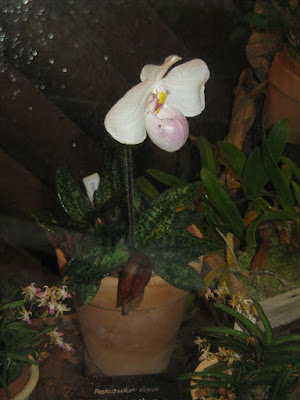Delanat's Paphiopedilum is native to Vietnam. Plants were initially found in an undisclosed location in Tonkin, a region covering the present northern Vietnam. A certain population of this species was recently discovered in the mountains of southern Vietnam in the region near Dalat west of Nha Trang. They usually grow on eastern and south-eastern slopes at heights of 1100-1200 m, but they were also found at an altitude of only 800 m, and at an altitude of up to 1500 m.
Paphiopedilum delenatii orchid, also called as Delanat's Paphiopedilum, Cypripedium delenatii, Paphiopedilum delenatii f. albinum, Paphiopedilum delenatii f. lutescens, Paphiopedilum delenatii f. vinicolor. This species was first described by Guillaumin in 1924.
IDENTIFY PAPHIOPEDILUM DELENATII ORCHID
Delanat's Paphiopedilum is native to Vietnam. Plants were initially found in an undisclosed location in Tonkin, a region covering the present northern Vietnam. A certain population of this species was recently discovered in the mountains of southern Vietnam in the region near Dalat west of Nha Trang. They usually grow on eastern and south-eastern slopes at heights of 1100-1200 m, but they were also found at an altitude of only 800 m, and at an altitude of up to 1500 m. The plants grow on eastern slopes in climatic conditions closer to conditions prevailing along the coast than the conditions of a mountain interior in the Dalat area. They grow in acidic soils formed from acidic granite substrates found usually in rock pits or on small shelves on steep granite slopes with a southern exhibition.
This species is a small sized, warm to cool growing terrestrial and lithophytic species with mottled leaves with 5 to 7, narrowly elliptic to oblong elliptic, distichous, light green and veined and mottled dark green, purple spotted beneath, obtuse and minutely unequally trilobed apically leaves. The leaves are up to 10 cm long and about 3 cm wide.
It blooms in late fall, winter (most often December) to early spring with 1 or 2 (rarely 3) apical flowers on an erect, 8 3/4" (22 cm) long, pubescent, reddish inflorescence. The dorsal petal and lower petal are white inside and pink outside with reddish spots. The inner coat flakes are almost the same color as the outer whorl flakes, but the spots on the outer surface are less pronounced. The petals of both whorls are covered with short, scattered hairs. The pocket-shaped lip is white and densely marked with a pink color. The base of the pollen chamber is dark pink with a yellow center and yellow spots at the base.
GROW AND CARE PAPHIOPEDILUM DELENATII ORCHID
Cultural information should only be used as a guide, and should be to be adapted to suit you. Your physical location; where you grow your plants, how much time you have to devote to their care, and many other factors, will need to be taken into account. Only then can you decide on the cultural methods that best suit you and your plants.
Light:
The plant need a source of light with 5,000-15,000 lux. Paphiopedilum delenatii can grow with a light level of around 35,000 lux, but when grown at a smaller dose of light, the flowers have a deeper shade of pink. Strong air movement should be ensured all the time.
Temperature:
The average daily temperature in summer is 26 ° C, at 17 ° C during the night, and the daily amplitude is 8-9 ° C. In winter, the average day temperatures are 21-22 ° C, and the night 13-15 ° C, with a daily amplitude of 6-8 ° C.
Humidity:
This species need a humidity of 75-80% for most of the year, increasing briefly to almost 85% in the autumn, rainy season.
Substrate and growing media:
The containers should be filled with a loose, permeable substrate that maintains moisture but does not absorb water. That plants grow better if moss is added to the substrate. Sick plants are often healed by placing them in living moss and irrigating them with rainwater or distilled water. It is interesting that the addition of sphagnum moss increases the acidity of the substrate, similar to the acidic conditions of the habitat. And the substrate should be regularly rinsed to prevent the accumulation of excess salt.
Watering:
The plants should be allowed to dry out between waterings for most of the year, but the condition should not be allowed if the plants remain dry for a long time. Increasing the amount of water from late summer to autumn simulates the conditions of the natural habitat, but plants may not need such abundant watering. As always, water low in salts is a must. This species requires less watering from January through May and water heavy from June through December, but not kept damp. To prevent excessive drying, plants should be sporadically sprinkled between watering, early in the morning, especially during bright sunny days.
Fertilizer:
Plants should be fertilized every week or every two weeks with 1/10-1/4 of the recommended dose of fertilizer for orchids. High-nitrogen fertilizer is beneficial at the beginning of the growing season, but at the end of the growing season the growers usually switch to high phosphorus fertilizer. Higher phosphorus content improves flowering in the next season and helps young grows before winter comes.
Rest period and repotting:
This plant have a period of rest, typically in fall and winter. While resting, watering should be reduced and fertilizer eliminated.
Delanat's Paphiopedilum are healthier if they are repotted to a fresh substrate each year. Repotting is best done immediately after flowering, when new roots begin to grow.















I have a delenatii and for the past two seasons the buds have blasted and died. I grow under lights in my home. Any ideas as to why this could be happening and how to avoid it in the future?
ReplyDelete